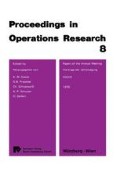Zusammenfassung
Zufallszahlen werden heute in vielen Teilen der Mathematik und ihrer Nachbargebiete wie Operations Research, Betriebswirtschaft,Ingenieurwissenschaften, Physik und Chemie gebraucht. Wir führen zwei Beispiele an:
-
(i)
Stochastische Vorgänge, z.B. Simulation eines Grenzüberganges. Die Zeit zwischen Ankünften zweier aufeinanderfolgender Autos genügt einem aus Beobachtungen bekannten Verteilungsgesetz. Die Autos werden an n Schaltern abgefertigt. Gefragt ist beispielsweise nach der Verteilung der Wartezeiten in Abhängigkeit von n.
-
(ii)
Numerische Prozesse, z.B. die Integration von Funktionen inIRn für großes n; die normalen Verfahren versagen dann. Bei CERN oder in Los Alamos werden daher derartige Integrale durch Simulation bestimmt: Sind u = (u1,...,u n) ∈ [0,1)n gleichverteilte Zufallsvektoren, so verwendet man die Riemann-Summen als Näherungsausdruck für das Integral. Es gilt nämlich nach Koksma und Hlawka
$$\left| \int\limits_{o}^{1}{f\left( {{u}_{1}},\cdots ,{{u}_{n}} \right)d{{u}_{1}}-d{{u}_{n}}-\frac{1}{n}\sum\limits_{i=1}^{N}{f\left( u_{1}^{\left( i \right)},\cdots ,u_{n}^{i} \right)}} \right|\le V\left( f \right){{\Delta }_{N}}$$(1)Dabei ist V(f) die Variation von f und ∆N die Diskrepanz der Folge u (1) die später diskutiert wird.
Access this chapter
Tax calculation will be finalised at checkout
Purchases are for personal use only
Preview
Unable to display preview. Download preview PDF.
Literatur
J.H. Ahrens, U. Dieter, and A. Grube, (1970): Pseudo-Random Numbers: A new proposal for the Choice of Multiplicators, Computing 6, 121–138.
W.A. Beyer, R.B. Roof, and D. Williamson, (1971): The Lattice Structure of Multi- plicative Congruential Pseudo-Random Vectors, Math. Comp. 25, 345–360.
R.R. Coveyou, (1969): Random Number Generation is too important to be left by Chance, Studies in Applied Mathematics, ( SIAM ), 3, 70–111.
R.R. Coveyou, and R.D. MacPherson, (1967): Fourier Analysis of uniform Random Number Generators, Journal A.C.M. 14, 100–119.
U. Dieter, (1971): Pseudo-Random Numbers: The Exact Distribution of Pairs, Math. Comp. 25, 855–883.
U. Dieter, (1972): Statistical Interdependence of Pseudo-Random Numbers Generated by the Linear Congruential Method, in: S.K. Zaremba (1972), 287–317.
U. Dieter, (1975): How to Calculate Shortest Vectors in a Lattice, Math.Comp.29, 827-833.
U. Dieter, and J.H. Ahrens, (1979): Pseudo-Random Numbers, Manuscript, 400 pp. A. Grube ( 1973 ): Mehrfach rekursiv erzeugte Zufallszahlen, Diss. Karlsruhe.
E. Hlavka, (1961): Funktionen von beschränkter Variation in der Theorie der Gleichverteilung, Ann. Mat. Pura Appl. 54, 325–333.
D.E. Knuth, (1969): The Art of Computer Programming, Vol. II, Seminumerical Algorithms. Addison-Wesley, Reading, Mass.
D. Lurie, and R.L. Mason, (1973): Empirical Investigation of several Techniques for Computer Generation of Order Statistics, Comm.Stat. 2, 363–371.
D.H. Lehmer, (1949): Mathematical Methods in Large-Scale Computing Units, Proc. 2nd Sympos. on Large-Scale Digital Calculating Machinery, Cambridge, Mass. 1949. Harvard Univ. Press, Cambridge, Mass., 141–146.
G. Marsaglia, (1968): Random Numbers fall mainly in the planes, Proc. Nat. Acad. Sci. 61, 25–28.
G. Marsaglia, (1972): The Structure of Linear Congruential Random Number Generators, in: S.K. Zaremba ( 1972 ), 249–285.
J. von Neumann, (1951): Various Techniques used in connection with Random Digits, Collected Works V, (1963), 768–770.
H. Niederreiter, On the Distribution of Pseudo-Random Numbers generated by the linear congruential method I, II, III, Math. Comp. 26 (1972), 793-795, 28 (1974), 1117–1132, 30 (1976), 571-597.
H. Niederreiter,, (1977): Pseudo-Random Numbers and optimal Coefficients, Advances in Math. 26, 99–181.
H. Niederreiter,(1978): Quasi-Monte Carlo Methods and Pseudo-Random Numbers, Bulletin A.M.S. 84, 957–1o41.
R.G. Stoneham, (1973): On the uniform e-distribution of residues within the periods of rational fractions with applications to normal numbers, Acta Arithmetica 22, 371–389.
S.K. Zaremba, (1966): Good Lattice Points, Discrepancy, and Numerical Integration, Ann. Mat. Pura Appl. 73, 293–371.
S.K. Zaremba, (1972): Applications of Number Theory to Numerical Analysis, Acad.Press.
Author information
Authors and Affiliations
Editor information
Rights and permissions
Copyright information
© 1979 Springer-Verlag Berlin Heidelberg
About this paper
Cite this paper
Dieter, U. (1979). Schwierigkeiten bei der Erzeugung gleichverteilter Zufallszahlen. In: Gaede, KW., Pressmar, D.B., Schneeweiß, C., Schuster, KP., Seifert, O. (eds) Papers of the 8th DGOR Annual Meeting / Vorträge der 8. DGOR Jahrestagung. Proceedings in Operations Research 8, vol 1978. Physica, Heidelberg. https://doi.org/10.1007/978-3-642-99749-5_33
Download citation
DOI: https://doi.org/10.1007/978-3-642-99749-5_33
Publisher Name: Physica, Heidelberg
Print ISBN: 978-3-7908-0212-2
Online ISBN: 978-3-642-99749-5
eBook Packages: Springer Book Archive

